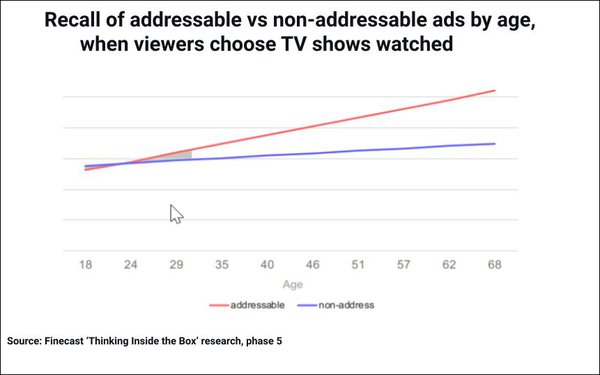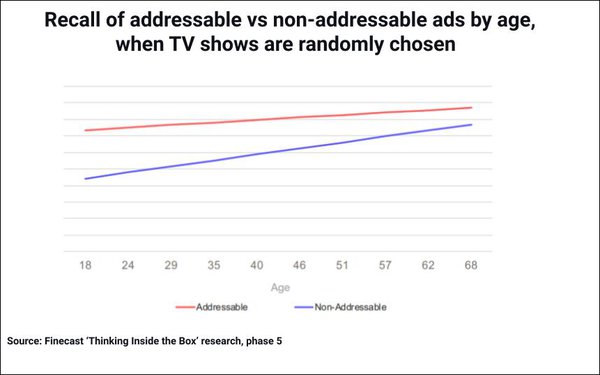Commentary
Your Brain On Addressable: More Engagement, Emotion, Recall
- by Karlene Lukovitz @KLmarketdaily, December 2, 2022


As various groups work to accelerate widespread implementation of addressable television, the targeting method continues to get periodic infusions of supportive findings from “Thinking Inside the Box,” a multi-phase research initiative spearheaded by Finecast, GroupM’s U.K.-based addressable TV platform.
The latest, just-released installment (phase five), conducted by scientists at University College London, found that addressable ads are more impactful than non-addressable ads in several ways because they produce greater brain activity in four key neural networks in the brain relating to attention, emotion, reward and memory.
advertisement
advertisement
For starters, the latest studies confirmed previous Finecast research showing that addressable ads are consistently correlated with higher levels of viewer attention. Not surprising, since it makes intuitive sense that people pay more attention to ads that are relevant to them.
Another key finding: Watching addressable ads — ads that are, again, in line with their interests — elicits stronger emotional and reward responses.
Addressable ads also result in higher recall than non-addressable ones, showing a 10% increase in accuracy, as well as faster response time.
They’re also better-recalled, across age groups, in any context — including whether or not the viewers have chosen the shows being watched (charts above). That was tested by having viewers watch addressable and non-addressable ads within TV shows that they selected, and within randomly selected shows.
Interestingly, both addressable and non-addressable ads tend to be better recalled among older age groups, but the higher recall of addressable ads was more marked among older viewers when seen within shows they selected.
If brands needed more encouragement to start experimenting with how addressable TV works best within their own marketing strategies, the study results would seem to provide pretty sound rationales.
“We found compelling evidence that addressable ads exert a robust effect on viewers, influencing both their neurological and behavioral engagement,” summed up Joseph Devlin, professor of cognitive neuroscience at University College London. “The ‘addressability uplift’ effect is noticeable in all four brain networks.”
“Viewers feel happier and nurture a sense of reward when they watch ads that resonate with them,” adds Harry Harcus, Finecast’s UK managing director. “In an advertising landscape where the battle for consumers’ attention is becoming increasingly fierce, reaching viewers with targeted ads will enable brands to gain a remarkable competitive edge.”
The research involved two experiments to determine how the brain responds to addressable ads.
In the first, conducted in the college’s lab, 24 participants had their brain activity recorded by fMRI while watching TV shows with ads that were either related to their interests (addressable) or not. This study probed what (if any) cognitive and neurological mechanisms were activated by addressable content.
The second experiment was conducted with 200 prescreened participants online. These participants were shown the same content as in the first experiment. Then their memory and recall for addressable content was measured using an online behavioral survey. This experiment was designed to measure what impact addressable TV ads have on participants’ memory and recall of relevant (addressable) ads versus non-relevant ads.
The full report can be downloaded here.




Good report, Karlene. It makes sense that ad recall is higher for consumers exposed to "addressable" ads when these are directed more towards audiences that might be interested in the product/service being promoted. In this study, the average recall "lift" for addressable ads was 20%, which seems credible. However, in The States, at least, the CPM differential between addressable TV and traditional TV---broadcast plus cable---- is considerably higher than 20%, so it is not a lock that every advertiser will go this route even if sufficient addressable GRPs were available. For some, this can make a lot of sense---especiaally at the outset of a new ad campaign or for a brand with an extremely selective user base. But not every media plan is going find the high cost for addressable TV acceptable.